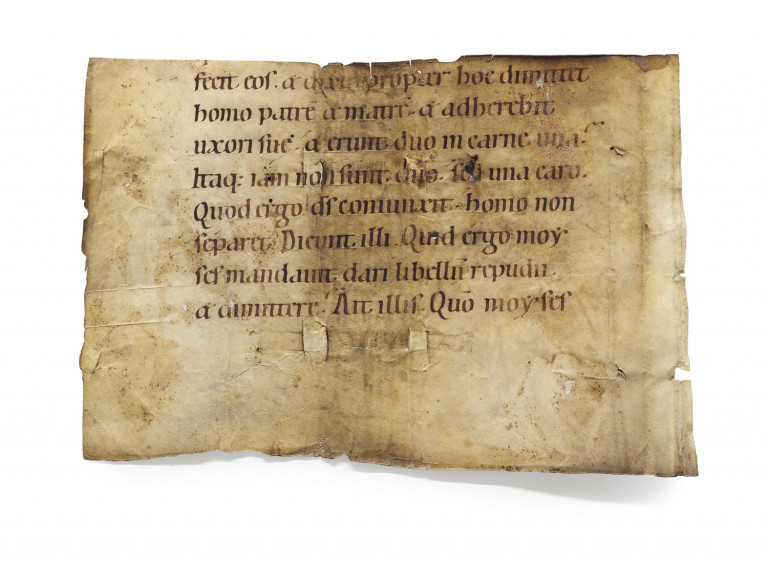Online Catalogue with all Lots / Auction 157
Rare Books, Prints, Historical Photography
Friday, 24 October 2025 at 11:00 am Lose 1- 1105
Saturday, 25 October 2025 at 11:00 am Lose 1106-2003 - After sale
Lot 193 Fragment einer karolingische …
Fragment einer karolingische Handschrift. Evangelium nach Matthäus. 8 Zeilen. Lateinische Handschrift auf Pergament. Karolingische Minuskel als Hauptschrift. Schriftraum 7,2 x 12,1 cm Format: 12,1 x 18 cm. Am rechten Rand mit 2 Naht- bzw. Bindungslöchern. West- bzw. Nordfrankreich, Westddeutschland, Mitte 9. Jahrhundert.
Mittelalter
Manuskripte und Urkunden – Proveninenz: Nachlass eines Buchbinders, Rheinland Pfalz. - Makulaturfragment aus einem Einband. - Die GRAPHEMFORMEN entsprechen der karolingischen Minuskel: rundes und offenes "a", gerades kurzes "d", flaches, offenes "e" mit Querstrich, rundes und isoliertes "r", langes "s". Ligaturen und Kürzungen sind zurückhaltend eingesetzt, ein Zeichen für die Reformschrift und deren Buchstabenisolation. Die PALÄOGRAPHIE ist leicht geneigt nach rechts und die Schrift wirkt schlank-deutlich. Die Handschrift zeigt ein gleichmäßig isoliertes Schriftbild und nutzt das Vierlinienschema konsequent aus, was auf eine hochwertige Ausführung und die Schreibschulen von Tours oder Corbie hindeutet. Ligaturen und Kürzungen sind nur sehr vereinzelt vorhanden, ein Zeichen für die reformierte Buchschrift und den klaren karolingischen Stil. Die Graphemformen und paläographischen Merkmale deuten auf eine Entstehung im Anfangs- oder Hochkarolingischen Schreibraum hin, wahrscheinlich im Bereich Westfranken (Tours/Corbie) oder Ostfranken (Aachen). Einige Elemente (offenes a, langes s, Unzial-r nach s) finden sich vergleichbar in Codex Parisinus Latinus 6115 und Ada-Gruppe. - Der INHALT enthält Matthäus 19:5-7, in dem Jesus über Ehe und Scheidung spricht. Recto die Phrase "... propter hoc dimittit homo patrem et matrem et adhaerebit uxori suae et erunt duo in carne una. Itaque iam non sunt duo sed una caro. Quod ergo Deus coniunxit homo non separet. Dicunt illi: Quid ergo Moyses mandavit dari libellum repudii ..." - - In der Mitte mit präparierten Bindungstreifen für die Lagenbänder eines Einbandes . - Verso und recto gebräunt (Ruß) und fleckig, sowie mit kleinen Fehlstellen, verso mit verrußtem Text. - Der nahezu "klassische" Duktus, die sehr gute Lesbarkeit und die konsequente Einhaltung normierter Formen sprechen besonders für ein bedeutendes Skriptorium und den Höhepunkt der karolingischen Schriftstandardisierung, etwa um die Mitte des 9. Jahrhunderts.
Manuscripts – Fragment of a Carolingian manuscript. Gospel according to Matthew, Latin manuscript on parchment. Carolingian minuscule as main script. Writing area 7.2 x 12.1 cm Format: 12.1 x 18 cm. Two stitching or binding holes on the right margin. Western or northern France, western Germany, mid-9th century. Provenance: Estate of a bookbinder, Rhineland-Palatinate. - Waste fragment from a book cover. - The GRAPHEMIC FORMS correspond to Carolingian minuscule: round and open 'a', straight short 'd', flat, open 'e' with a crossbar, round and isolated "r", long 's'. Ligatures and abbreviations are used sparingly, a sign of the reformed script and its letter isolation. The PALAEOGRAPHY shows a slight rightward slant and the script appears slender and clear. The handwriting shows a uniformly isolated typeface and makes consistent use of the four-line scheme, which indicates high-quality execution and the writing schools of Tours or Corbie. Ligatures and abbreviations are only very sporadic, a sign of the reformed book script and the clear Carolingian style. The grapheme forms and palaeographic features indicate that it originated in the early or high Carolingian writing area, probably in the region of West Francia (Tours/Corbie) or East Francia (Aachen). Some elements (open a, long s, uncial r after s) are found in a similar form in Codex Parisinus Latinus 6115 and the Ada group. - The CONTENTS contain chapter 19 (Matthew 19:5-7), in which Jesus speaks about marriage and divorce. Recto the phrase "...propter hoc dimittit homo patrem et matrem et adhaerebit uxori suae et erunt duo in carne una. Itaque iam non sunt duo sed una caro. Quod ergo Deus coniunxit homo non separet. Dicunt illi: Quid ergo Moyses mandavit dari libellum repudii ..." - - In the center with prepared binding strips for the phylloxera of a binding. - Vero and recto browned (soot) and stained, as well as with small missing parts, verso with rusted text. - The almost "classical" style, the excellent legibility, and the consistent adherence to standardized forms speak particularly for a qualified scriptorium and the high point of Carolingian script standardization, around the middle of the 9th century.
Result: 1100 €
Premium and taxation
This work is subject to under the regular margin scheme. There is a 24.95% buyer's premium on the hammer price and inside the EU 7% (Books, Paintings, Drawings and most Prints) and 19% (Photographs, Screen and Offsetprints, Autographs and Manuscripts) VAT on the final invoice amount.
Shipping
A pickup of this work is possible in our premises at Potsdamer Str. 16, 14163 Berlin by appointment. If you wish a shipment of the work, please contact us for a consultation and shipping calculation.
Terms and Conditions
You can view our terms and conditions here
Droit de Suite
On the sales proceeds of all original works of fine art and photography, whose authors have not yet died 70 years before the end of the sale, an additional 2% (subject to change) of the hammer prices from 400€ will be charged pro rata for the VG Bild-Kunst, which represents the copyrights of visual artists according to § 26 UrhG.
Submit a bid
I would like to participate in your auction by accepting the General Terms and Conditions of Jeschke van Vliet Auctions Berlin GmbH.
